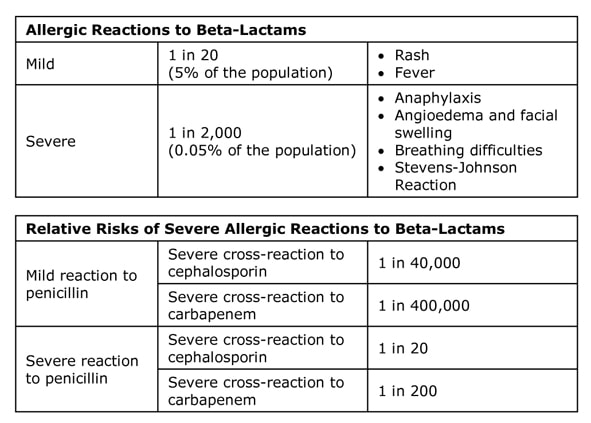Allergy to Penicillin (Beta-Lactam Antibiotics)
Side effects from antibiotics are common (e.g. diarrhoea and vomiting) and do not usually represent allergy. If patients are unclear about the nature of any drug reaction it is important to seek clarification from their relatives, carers or general practitioner.
Up to 20% of patients say they are allergic to penicillin; the actual rate is only 5%. On closer questioning what patients are describing are either side effects or a symptom unrelated to the antibiotic. It is important to distinguish true allergy from side effects and to explain to patients that restricting choices of antibiotics, due to incorrect reporting of penicillin allergy, can cause unnecessary risks to patient safety through less effective or more toxic treatments. For example, a patient with an ESBL-positive Escherichia coli UTI and a history of severe Beta-lactam allergy may require treatment with Colistin and Amikacin, which predisposes to a high risk of renal failure.
Side effects do not necessarily prevent the use of antibiotics in future episodes of infection.
Up to 20% of patients say they are allergic to penicillin; the actual rate is only 5%. On closer questioning what patients are describing are either side effects or a symptom unrelated to the antibiotic. It is important to distinguish true allergy from side effects and to explain to patients that restricting choices of antibiotics, due to incorrect reporting of penicillin allergy, can cause unnecessary risks to patient safety through less effective or more toxic treatments. For example, a patient with an ESBL-positive Escherichia coli UTI and a history of severe Beta-lactam allergy may require treatment with Colistin and Amikacin, which predisposes to a high risk of renal failure.
Side effects do not necessarily prevent the use of antibiotics in future episodes of infection.

Topics in Antibiotics:
All these topics are covered in the book...Ready to buy your copy? Click here to buy your copy of "Microbiology Nuts & Bolts" Its updated and amazingly only slightly larger considering its got 1/3 more in it! (11cmx18cmx2.5cm).
- Antimicrobial Stewardship
- How Antibiotics Work - Mechanisms of Action
- How to Choose an Antibiotic
- Prophylaxis vs. Treatment
- How to Prescribe an Antibiotic
- The Daily Review of Antibiotic Therapy
- Reasons for Failing Antibiotic Therapy
- Intravenous to Oral Switching of Antibiotics
- Therapeutic Drug Monitoring (TDM)
- Interpretation of TDM
- Antibiotic Dosing in Adult Renal Impairment
- Adjustment of Antibiotic Doses in Adult Renal Impairment
- Antibiotic Dosing in Obesity
- What is Antibiotic Resistance?
- How Resistance Occurs - Mechanisms of Resistance
- How is Antibiotic Resistance Spread?
- How is Antibiotic Resistance Detected in the Laboratory?
- Table of Antibiotic Spectrum of Activity
- Table of Antibiotic Tissue Penetration
- Allergy to Beta-Lactam Antibiotics
- Including pages on each: Penicillins, Cephalosporins, Carbapenems and Aztreonam, Trimethoprim and Co-Trimoxazole (Septrin), Erythromycin, Clarithromycin, Azithromycin and Clindamycin, Gentamicin, Amikacin and Tobramycin, Ciprofloxacin and Levofloxacin, Vancomycin and Teicoplanin, Daptomycin, Metronidazole, Doxycycline, Tigecycline and Tetracycline, Linezoli, Rifampicin, Fusidic Acid, Colistin, Chloramphenicol, Nitrofurantoin, Fidaxomicin, Fosfomycin, Antimycobacterials, Antifungals and Antivirals
All these topics are covered in the book...Ready to buy your copy? Click here to buy your copy of "Microbiology Nuts & Bolts" Its updated and amazingly only slightly larger considering its got 1/3 more in it! (11cmx18cmx2.5cm).


